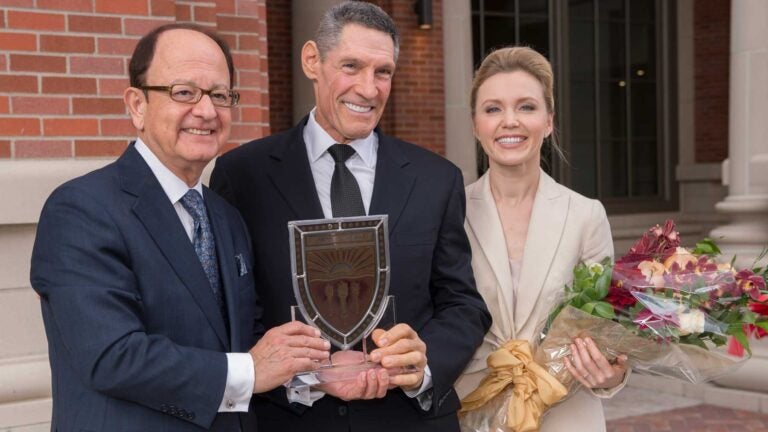
USC President C. L. Max Nikias, Gary K. Michelson and Alya Michelson celebrate the grand opening of Michelson Hall. (USC Photo/Gus Ruelas)
USC’s Michelson Hall, new center for convergent bioscience, makes its debut
The facility — the largest research building on the University Park Campus — provides a revolutionary environment for collaborative research
In the near future, USC researchers might be talking about medical breakthroughs made while chatting with engineers in line for an espresso at Michelson Hall — noting the ideas on a nearby touchscreen and saving their thoughts to the cloud.
Michelson Hall debuted Wednesday at USC’s University Park Campus. It will be the home of the USC Michelson Center for Convergent Bioscience, bringing great minds from disciplines all over the campus — from the USC Dornsife College of Letters, Arts and Sciences, the USC Viterbi School of Engineering and the Keck School of Medicine of USC — under one roof to solve the world’s most pressing health problems.
“This is a team united in the search of cures, with expertise in chemistry, biology, medicine, mathematics, engineering, physics and sciences,” USC President C. L. Max Nikias said at the opening ceremony. “It’s a daring partnership in biotech.”
It’s the largest building on the University Park Campus, with 190,000 square feet of laboratory and office space. The $185 million facility will house everything from fabrication and wet labs to conference rooms and research space. It’s part of an overall effort to make L.A. a hub for biotech.
“The USC Michelson Center will be the touchstone of a biomedical corridor that will stretch from East L.A. and our Keck School of Medicine to the Pacific Ocean,” Nikias said.
The building is the result of a $50 million gift from retired orthopedic spinal surgeon Gary K. Michelson and his wife, Alya Michelson.
Early problem-solver
Michelson’s approach to problem-solving came early. While staying home sick from school one day, he sneaked in to watch TV against his parents’ wishes. When the TV stopped working, he knew he would get in trouble so he ran off to the five-and-dime for a new tube, opened up the back end and got it to work — though not before his brother caught him.
As a young surgeon, he saw the inefficiencies of spinal surgery, and he later developed instruments, implants and procedures to make spinal surgery quicker, safer and less expensive. He holds more than 950 patents, mostly related to spinal fusion and surgical implants.
The USC Michelson Center aims to capture that spirit of innovation and inquiry by putting nearly 30 scientists and engineers side-by-side to tackle issues such as cancer, autism and brain development. Some of the center’s work has already started, such as a National Institutes of Health-funded project on zebrafish, using the underwater creature to see how memories are formed in the brain, or an iPhone app that can predict a heart attack before common symptoms appear.
Its facilities were made with microscopic attention to detail, such as testing the soil for compactness and insulating against the vibrations of the nearby Expo Line, which could throw off an electron microscope zeroing in on a nanoparticle.
Steve Kay, director of convergent bioscience at USC, said that to create innovative solutions, there needs to be a lot of different mindsets approaching a problem. Kay would know: He’s moving his lab, which researches circadian rhythm, to the new building.
“We want to remove our barriers of expertise and connect to all of our colleagues in this building.”
— Steve Kay, USC director of convergent bioscience
“We need to work with chemists and mathematicians and engineers,” Kay said. “Although circadian rhythm has told us a lot how the body functions, we need to create drugs for diseases related to circadian rhythm — sleep disorders, cardiovascular disease, cancer. We reached the limits of what we can solve on our own. By moving into this building, we want to remove our barriers of expertise and connect to all of our colleagues in this building.”
On the cutting edge
USC’s is one of only a few convergent bioscience institutions in the country, the first being the Whitehead Institute for Biomedical Research at the Massachusetts Institute of Technology.
The idea is the researchers won’t just collaborate formally, but can also run into each other in the hallways, in its restaurant — or at that espresso machine.
“You can’t top-down micromanage discovery,” Kay said. “What you need to do is build runways, not fences. This building is a runway that brings together people who might never meet.”



